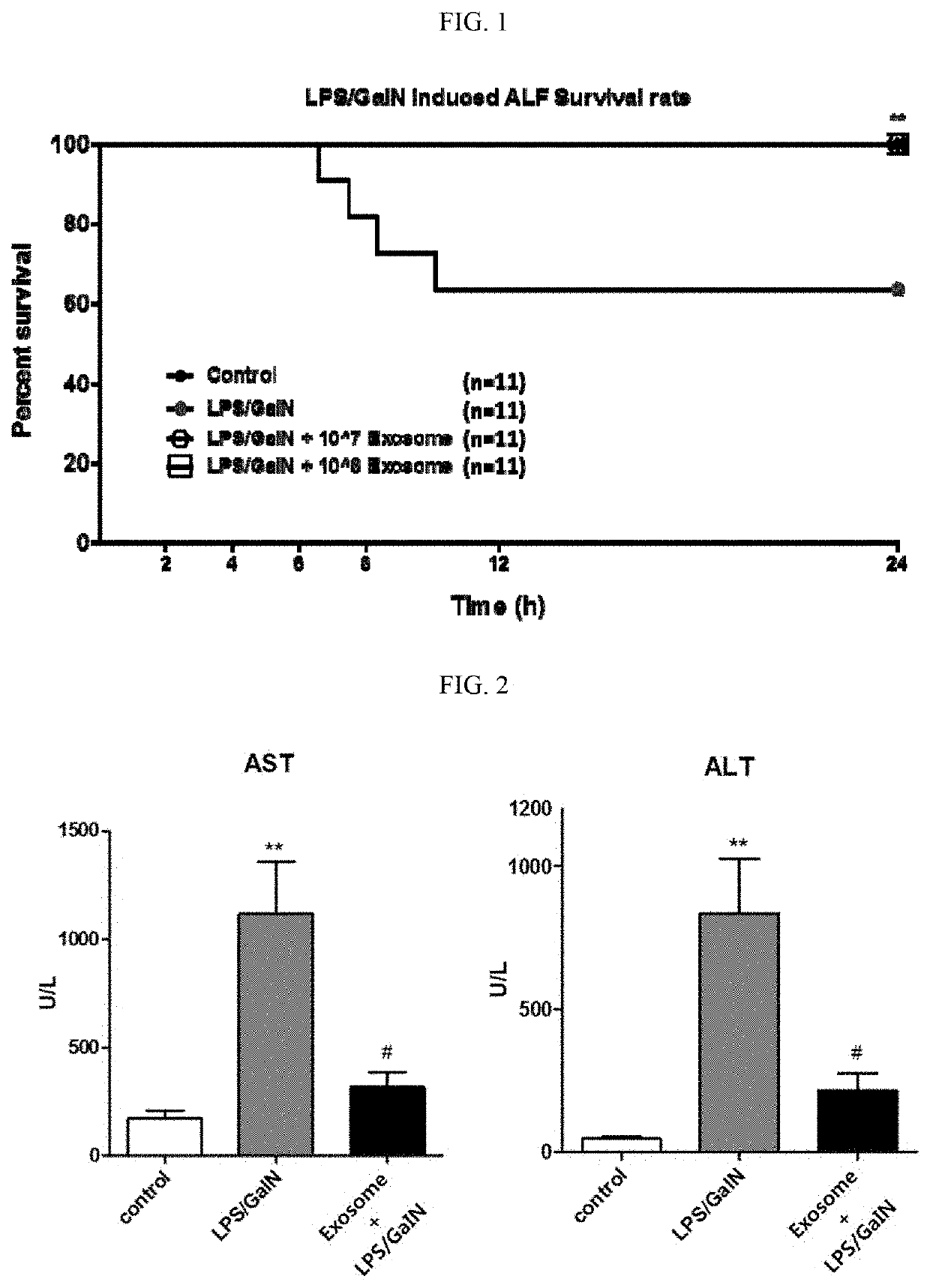Composition comprising exosome as effective ingredient for prevention or treatment of acute liver failure
a technology of exosomes and liver failure, which is applied in the field of compositions for preventing, improving or treating acute liver failure, can solve the problems of not being so good for acute liver failure in terms of disease progression and therapeutic, and further studies are necessary, so as to improve the levels of aspartate aminotransferase (ast) and alanine, prevent, improve or treat acute liver failure, and improve the effect of aspartate aminotransferas
- Summary
- Abstract
- Description
- Claims
- Application Information
AI Technical Summary
Benefits of technology
Problems solved by technology
Method used
Image
Examples
example 1
Isolation of Exosomes from Adipose-Derived Mesenchymal Stem Cells and Analysis of Characteristics
[0073]Exosomes were isolated from human adipose-derived stem cells during a procedure of culturing human adipose-derived stem cells.
[0074]Specifically, human adipose-derived stem cells were cultured in a DMEM (Dulbecco's modified Eagle's medium, high glucose) medium containing 10% fetal bovine serum (FBS) and 1% penicillin / streptomycin. 24 hours before the isolation of exosomes, the medium was replaced with a serum-free, antibiotic-free, phenol red-free medium. After culturing for 24 hours, a supernatant was recovered from the cell culture. After the supernatant was recovered, a normal culture medium was added and the stem cells were cultured again. This procedure was repeated until passage 7.
[0075]Cell debris and wastes were removed from the recovered cell culture supernatant by centrifuging at 2,000×g and 4° C. for 10 minutes and filtering through a bottle top filter (pore size; 0.22 μ...
example 2
Establishment of Acute Liver Failure-Induced Animal Model
[0077]For establishment of a fulminant liver disease animal model, 3-week-old ICR male mice were habituated for a week. After fasting for 18 hours on the previous day of 4 weeks of age, 20 μg / kg LPS (lipopolysaccharide) and 800 mg / kg GalN (D-(+)-galactosamine) were administered intraperitoneally. For preventive purpose, 107 or 108 exosomes were administered by intravenous injection every day from two days before the administration of LPS / GalN, for a total of two times. For therapeutic purpose, 107 or 108 exosomes were administered 3 hours after the administration of LPS / GalN.
example 3
Confirmation of Increased Mouse Survival Rate Due to Administration of Exosomes to Acute Liver Failure-Induced Animal Model
[0078]After the administration of LPS / GalN, mouse survival rate was measured for 24 hours. The number of mice which died after the administration of LPS / GalN was counted with time. The survival rate was plotted on a graph using the GraphPad Prism program and was analyzed statistically with the Kaplan-Meier estimator and the log-rank test. As a result, out of the 11 mice administered with LPS / GalN only, four mice (36.36%) died, at 6 hours and 35 minutes, 7 hours and 30 minutes, 8 hours and 20 minutes, and 10 hours and 6 minutes after the administration of LPS / GalN, respectively. In contrast, all of the 11 mice administered with LPS / GalN and 107 or 108 exosomes survived after the administration of LPS / GalN (100%). As a result of analyzing the statistical difference of the survival rate with the Kaplan-Meier estimator and the log-rank test, the group administered o...
PUM
 Login to View More
Login to View More Abstract
Description
Claims
Application Information
 Login to View More
Login to View More - R&D
- Intellectual Property
- Life Sciences
- Materials
- Tech Scout
- Unparalleled Data Quality
- Higher Quality Content
- 60% Fewer Hallucinations
Browse by: Latest US Patents, China's latest patents, Technical Efficacy Thesaurus, Application Domain, Technology Topic, Popular Technical Reports.
© 2025 PatSnap. All rights reserved.Legal|Privacy policy|Modern Slavery Act Transparency Statement|Sitemap|About US| Contact US: help@patsnap.com


